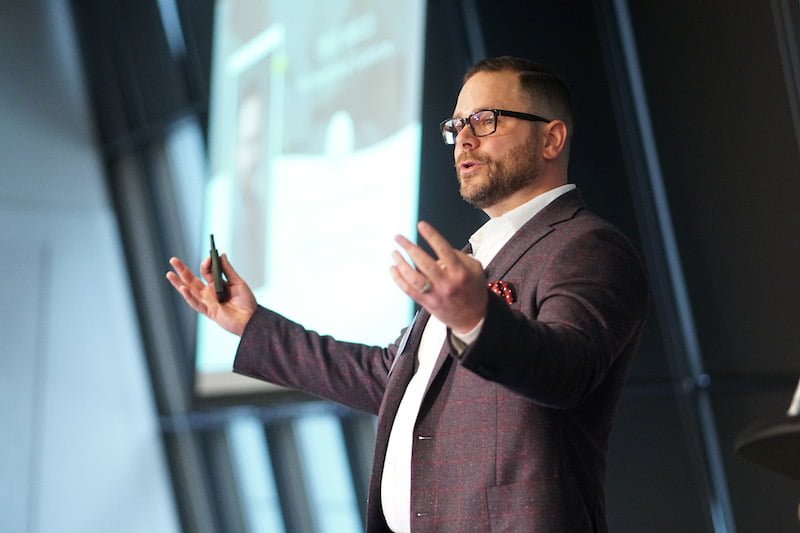You’ve watched excitedly as your YouTube channel continues to climb, your subscriber count shooting up. You’ve even gotten a few YouTube plaques mailed to you for your accomplishments. As your channel attracts more attention, you’re thinking of working with sponsors. How do you attract sponsors to your YouTube channel?
Here’s how to get sponsorship for your YouTube channel:
- Understand your audience
- Research your prospects
- Create an asset inventory
- Valuate your assets
- Plan activation ideas
- Put together a sponsorship proposal
- Meet with sponsors
- Deliver on ROI
- Produce a fulfillment report
This guide will tell you everything you need to know about obtaining sponsorship for your YouTube channel. I’ll talk about how your account can benefit from sponsorship, elaborate further on the 9 steps above, and even share sponsorship mistakes to avoid.
To accompany this post, here are a few more articles we recently shared that will provide expertise in your niche profession.
You won’t want to miss them!
- Sponsorship for Influencers
- Podcast Sponsorship Opportunities: 5 Examples of Sponsorship Done Well
- The Complete Guide to Podcast Sponsorship
- How to Create a Podcast Sponsorship Agreement
- How to Get Sponsorships for Podcasts: 6 Steps to Success
- How to Create a Podcast Sponsorship Proposal That Sponsors Will Love
- How to Market Your Podcast
- How to Grow a Podcast
- How Much Should You Charge for Podcast Sponsorship
Let’s get started!
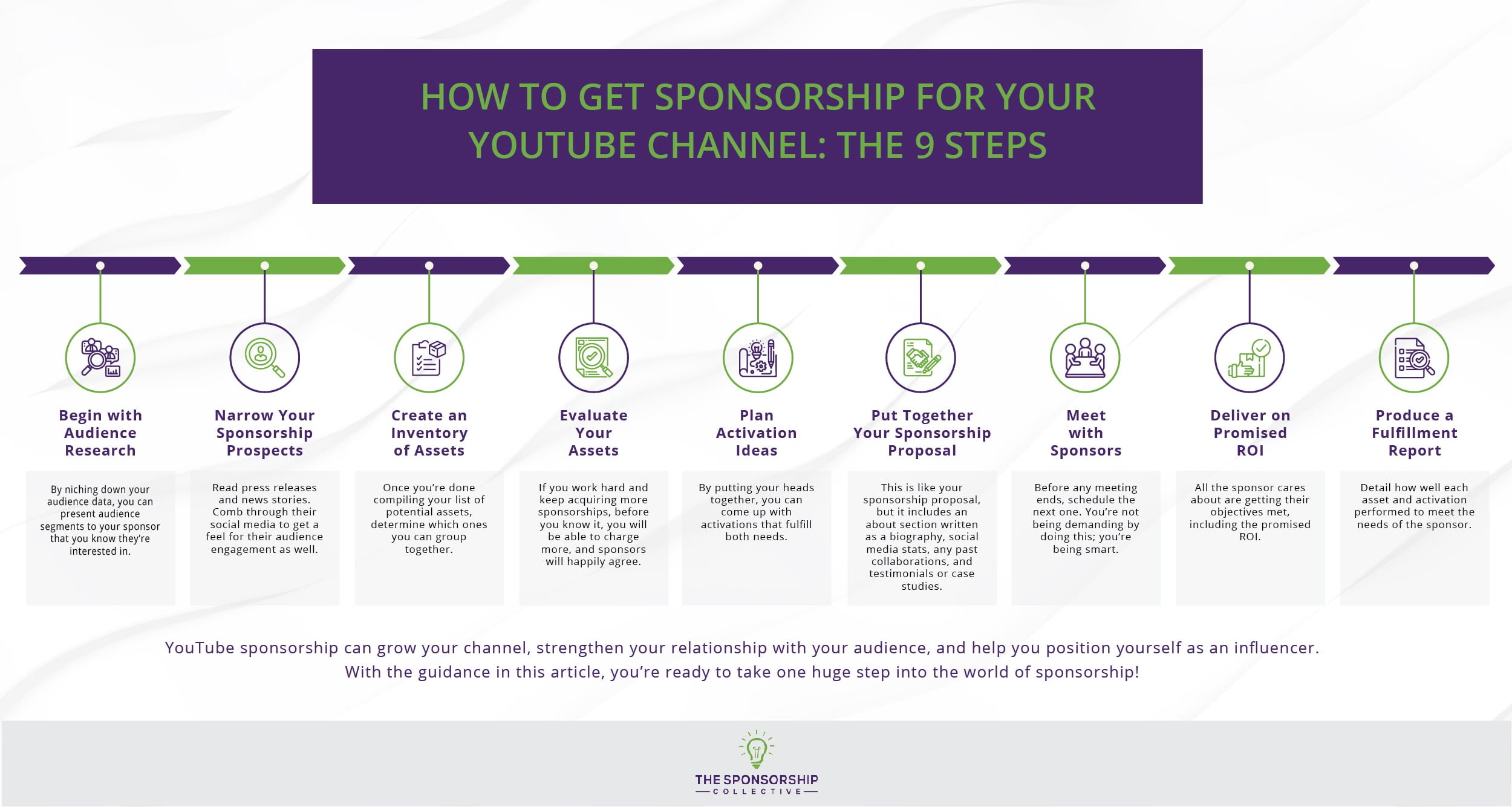
How to Get Sponsorship for Your YouTube Channel
What Is YouTube Sponsorship?
Why You Need It!
According to 2021 data from Statista, YouTube has 1.86 billion viewers. Marketing resource Backlinko states that, of the YouTube viewers in the United States, 68 percent of them go on the site every day. YouTube is a huge platform that continuously churns out new stars.
The chances are quite good that your favorite YouTuber has a sponsorship or several. Usually, a YouTuber will take a short break midway through their video to talk about the sponsor. The YouTuber typically has an exclusive discount code their viewers can use to try the sponsored product or service. It’s becoming the norm.
Let’s rewind for a moment and talk about what sponsorship is.
Sponsorship is a partnership between you as a YouTuber and another individual, company, or organization. You select a sponsor you want to work with, or the sponsor comes to you. Together, you arrange a deal where you promote their service or product to your audience during a video.
In return, there are benefits for you as a YouTuber, usually in the form of a nice payday. You’d earn the typical YouTube ad revenue, plus, you’re often allowed to keep whatever products/services you’re given as part of the deal.
How else can you benefit by seeking a sponsor? Here are some other perks to mull over.
Grows Your Reach as an Influencer
As a YouTuber, it’s not enough to post videos anymore. You must be an influencer too. I just wrote a huge post about influencer sponsorship that I highly recommend you read if you haven’t already.
Once you become an influencer, more opportunities tend to follow. If your sponsorships are successful, you might not even have to seek sponsors anymore. They could all come to you! This will allow you to pick and choose the sponsors you work with thoughtfully, curating only products and services that fit your brand.
Can Put You on the Map
Once you become a major influencer/YouTuber, who knows where your career as an Internet celebrity can go? Perhaps you transition into acting, singing, or other forms of performing. You might even end up on television. YouTubers are huge celebrities these days, after all, so the possibilities are truly endless.
Keeps Your Creativity Going
As a YouTuber, one of the hardest parts is coming up with innovative ideas that everyone else hasn’t done. You can’t let your editorial calendar dry up, as people are relying on you to post videos, but what do you do when you run out of ideas?
This form of creativity block happens to the best of us. Working with sponsors can naturally inspire your creativity in ways it wasn’t piqued before.
Connects Your Audience to Products/Services They’d Really Like
One of the best parts of getting a YouTube sponsorship is how you can share products and services with your audience that you’re genuinely excited about. You know that without your audience, you wouldn’t be where you are today, so they mean everything to you.
You only want to recommend products and services they’d like so you can use your platform for good.
As a caveat, before you proceed with YouTube sponsorship, I always recommend that you carefully read over and verify all of YouTube’s current rules about revenue generation. If you have a lawyer, I’d suggest consulting with them before proceeding with any sponsorship deal. If you don’t have a lawyer, get one.
You don’t want to accidentally violate any of YouTube’s terms of service. Your video can be removed, which will cost you revenue. Your channel can also be penalized and possibly deleted if you break YouTube’s three-strike policy.
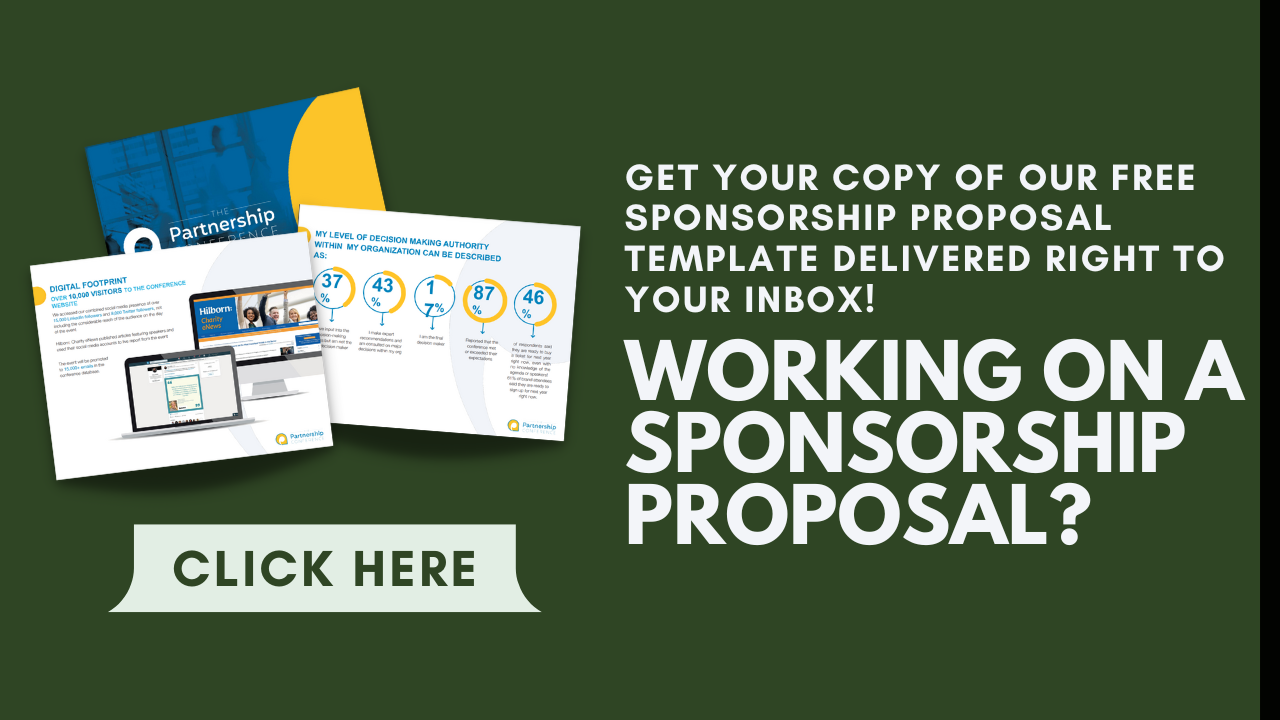
How to Get Sponsorship for Your YouTube Channel: The 9 Steps
You know how to get clicks and views on your YouTube channel, but sponsorship is an area you’re not familiar with. That’s where I come in.
Here are 9 steps to sponsorship success that I recommend all my clients start with when putting together their sponsorship program.
Begin with Audience Research
Your audience means the world to you, but do you know who they are? I don’t mean names either, but the data that really matters.
For example, what are the occupations of your audience? How much money do they make per year? What other brands do they like to consume?
If you can’t answer these questions, then the first step of your sponsorship program is to get to know your audience.
I recommend audience research for so many reasons. If you don’t know who your audience is, then how can you determine which sponsors are viable for you to promote? You can’t.
We live in an age of cancel culture nowadays. If you choose just any sponsor because you don’t know what your audience wants and that sponsor ends up being a huge mismatch, your audience could turn on you in record numbers. I’m not saying you’d be canceled, per se, but I’m not saying it’s impossible either.
You need to know who comprises your audience, what they like, and what they need. Then you can say, “okay, Segment A is my younger female crowd, and a makeup sponsor just contacted me. I’ll make a video for them.”
How do you get to know your audience? Through an audience survey. Since you have enough clout with your viewers, all you have to do is make a short YouTube video about the survey, include the survey link in the description, and upload the clip. I guarantee you will get a huge number of responses.
I always recommend incentivizing the audience, which isn’t a bad idea for you to do too. You don’t necessarily have to give away something for free, but that’s an option. Even if it’s a t-shirt or a signed item, I’m sure your audience members would be jazzed to have it.
Give your audience several weeks to send in the survey. You can upload a video a week before you close the survey reminding people to take it and what the prize is.
Once you have your audience data, it’s time to evaluate it. The goal is to separate audience members by similarities. As you get started, it’s okay if the similarities are broad. For example, you can begin by segmenting male and female audience members.
Then you want to begin to segment by more specific criteria, like male audience members on the east coast. You can get more specific than that though, such as male audience members in New York or Pennsylvania.
And yes, you can get even more specific, such as male audience members in New York City versus Brooklyn versus the Bronx. Then you can begin dividing your male audience members by other demographics such as age, occupation, income, or pain points.
It’s sort of like opening a Russian nesting doll only to find another nesting doll inside. You want to keep segmenting your audience (opening the dolls) until you can go no further.
Is this a lot of work? Yes. Is it time-consuming? Absolutely, but it’s valuable, and let me show you why with an example.
Imagine you own a jewelry store. When someone comes in, you don’t want to show them everything in the store. Instead, you want to guide them towards a selection of jewelry you’ll know they’re interested in and thus will be more likely to buy.
So let’s say a young couple comes in. They begin eyeing up the rings. You know they’re interested in engagement rings. Then you overhear them talking about princess cut engagement rings, so you present your finest selection to them.
That’s the same way your audience data works in sponsorship. By niching down your audience data, you can present audience segments to your sponsor that you know they’re interested in.
Narrow Your Sponsorship Prospects
How can you be sure what your sponsor is interested in? You have to research them.
Although I would say that audience data is arguably the most important part of your sponsorship program, you must take the time to thoroughly investigate your sponsorship prospects.
Remember, it’s your reputation on the line here. If you choose a company or individual who’s unscrupulous but you find that out after the fact, there’s no going back at that point.
How do you even find prospects? As I said, with time, they could come to you. Until you reach that point though, you have to do your own digging.
I have a post on sponsorship prospecting that will be your best friend during this stage of your sponsorship program. To recap that post, you need to create what’s known as a concentric circle with four rings within it.
As the rings move outward, your prospects get colder. In the center of the circle are the brands that your audience mentioned enjoying/using/consuming during the audience survey. Then you need to determine, based on the brands your audience consumes, which companies would advertise to your audience. That’s the second circle.
The third circle includes brands that should be interested in your audience but don’t directly advertise to them. Then the fourth circle is all the direct competitors of the other three circles.
If you follow my recommendations outlined in that post, you could have 50, 60, or more sponsorship prospects on your plate.
How do you research them? I recommend starting with their website and thoroughly reading their about sections and other webpages. Check out their products and services on their store as well. Knowing what you do about your audience, do these products/services resonate with you?
Read press releases and news stories, but don’t go too far down a rabbit hole. Comb through their social media to get a feel for their audience engagement as well.
Create an Inventory of Assets
By now, you’re ready to begin creating assets. What’s an asset, I’m sure you’re asking? This is something I covered on the blog recently, but I’ll recap that info as well.
An asset is something of value to the sponsor, tangible or intangible. Since your content is on YouTube, most of your assets will be intangible. For example, perhaps in your next 15-minute video, you spend three minutes talking about a sponsor’s product or service.
You must have more than one asset available, so think of what else you can offer the sponsor. Perhaps you post about them on Twitter five times over the course of a month or you cross-post your YouTube video on your Facebook and Instagram, both of which have followers in the hundreds of thousands.
You might sit down with a brand ambassador or someone else who’s been heavily involved in your YouTube channel to determine which assets you can present to a potential sponsor. Start with a long list that’s undiscerning in its content. Trust me, you will narrow the list down as you go.
Once you’re done compiling your list of potential assets, determine which ones you can group together. These related properties become your asset inventory.
Evaluate Your Assets
With your asset inventories drawn up, now comes what is admittedly the difficult part. You must determine the value of your assets, which is also known as a valuation.
I normally recommend a combination of competitor pricing, geographics, and market data to determine how to price your assets. For YouTubers, you have to look at your cost per thousand impressions or cost per mille, which is abbreviated as CPM.
Your CPM is how much money you make per 1,000 impressions without YouTube’s revenue share kicking in. With the revenue share taken out, that’s your revenue per mille or RPM, by the way.
According to millennial resource Jonas Muthoni, for every 1,000 views, the average YouTuber charges a sponsor anywhere from $10 to $50 depending on how many views the video is projected to get.
Yes, that means you could earn between $10,000 and $50,000 if your video gets a million views, but that’s no small feat.
I recommended this in my post on sponsorship for influencers, and I want to suggest it again now. You cannot overcharge your valuations. You must make an honest assessment of your brand when determining asset value.
Use your follower counts as your guide. If your YouTube channel has 10,000 to 50,000 subscribers, then you’re technically considered a micro-influencer. Macro influencers have over 150,000 subscribers and mega influencers boast at least 500,000 subscribers.
If your YouTube channel is on the smaller side, you can still make a nice payday from your assets, but you won’t earn as much money as a mega influencer would. And that’s okay. If you work hard and keep acquiring more sponsorships, before you know it, you will be able to charge more, and sponsors will happily agree.
Plan Activation Ideas
The next part of the sponsorship program is coming up with activation ideas.
Activations are experiential marketing opportunities that link your audience with your sponsor. That’s truly the most important goal in activation, solving a need of your audience and your sponsor simultaneously.
As you can imagine, you cannot come up with effective assets if you glossed over (or skipped) your audience research and barely looked into your sponsorship prospects. Please, before you go any further, if you didn’t do sufficient research, go back and take the time to do so now. It’s not too late to get your sponsorship program on track.
What kind of activation opportunities can you present to a sponsor in the context of YouTube? Perhaps you do a giveaway on your channel where the prize is one of the sponsor’s products or services. You could come up with an app, an interactive game, or a virtual scavenger hunt that requires participants to go on your website and the sponsor’s site.
I can’t tell you whether those ideas will check the boxes for your audience and your sponsor, as that varies on a case-by-case basis. That’s why I always recommend getting the sponsor’s input about activation opportunities.
The sponsor understands their own problems best while you know what your audience’s pain points are. By putting your heads together, you can come up with activations that fulfill both needs.
I do want to point out that activation ideas do not always have to cost several hundred dollars and certainly not several thousand dollars. I’ve seen great activation ideas that were very expensive just as I’ve seen many fantastic ones that were cheap and even free.
What matters most is fulfilling needs with your activations, not that it’s a flashy, overly costly idea.
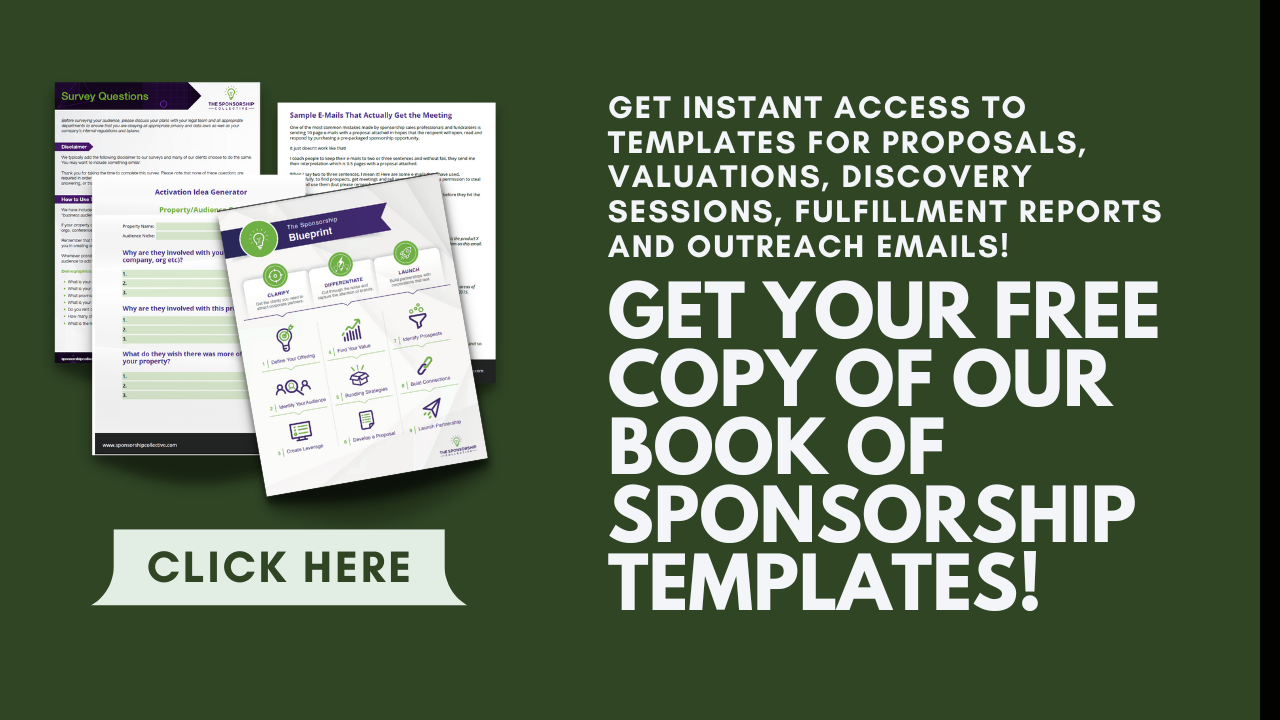
Put Together Your Sponsorship Proposal
The final bit of prep work you have to do is write your sponsorship proposal.
The sponsorship proposal is an amalgamation of all the information you’ve gathered for your sponsorship program to this point. The proposal includes your audience data, information about your channel (and yourself), your assets, and what your sponsorship request is.
It’s a succinct, six-page document, and one of those pages is the title page while the latter page has contact information. So really, it’s four pages. Writing those four pages all willy-nilly though is a great way to turn off a sponsor from what could have been shaping up to be a good deal.
I have a sponsorship proposal template you can follow from start to finish. I include information on how to write all six pages, including paragraph-by-paragraph recommendations in some instances.
I do want to take some time to discuss the sponsorship menu, which is where you arrange your assets. I always push my clients to offer their sponsors a customized sponsorship menu instead of the dated, restrictive gold, silver, and bronze tiers.
Tiered sponsorship packages are so common they’re long since played out. Everyone uses them, from your competitors to the competitors of your competitors. For some people, they don’t know any better. Others think they’ll hoodwink a sponsor by cramming a gold tier full of awesome assets and then leaving the silver and bronze tiers practically empty.
You’ve worked so hard to get to this point. Don’t screw it up now by trying to strongarm a sponsor. It doesn’t even usually work out the way you were expecting anyway. Tiered sponsorship levels tend to leave money on the table, which means less cash in your pocket!
In my article on influencer sponsorship, I suggested putting together a media kit. This is like your sponsorship proposal, but it includes an about section written as a biography, social media stats (like audience, viewers, subscribers, etc.), any past collaborations, and testimonials or case studies.
Meet with Sponsors
The time has come for you to reach out to your sponsorship prospects.
Please, even if they have a sponsorship form on their website, refrain from filling it out. Instead, you need to find the contact information of someone in the sponsorship department, be that a phone number or an email address. You can even use social media direct messaging (DMing) to reach out.
In the above-linked post to sponsorship for influencers, I shared a template pitch you can use for your first contact with a prospective sponsor. I’ll share it again here. I want to remind you that you should edit the pitch so it feels more like you.
Hello [name of contact at company],
My name is [your name] and I’m a YouTuber/influencer in [niche]. I’ve been a big fan of your [ product/service ] for a long time and I personally use it regularly. I was wondering if you might
be interested in a deal where I can promote your [ product/service ] on YouTube?
My YouTube account is [account name]. You’ll see that I talk a lot about [niche].
My YouTube channel attracts a big following of [number of subscribers] who love to check out my thoughts and recommendations.
It’s my goal to provide my audience with [ products/services ] they’ll love, and I think we’d be a
great fit! I have collaboration experience from working with [past partnerships].
I’m happy to send my media kit if you want to check it out. You can also visit my website [web
address] for more information.
Thanks so much for your time!
When you hear back, you want to schedule a discovery meeting with the sponsor. You might meet with them over the phone or through video chat, but likely not in person. Even still, there are some first meeting dos and don’ts I cover in this post. Read up before the meeting!
The purpose of the discovery session is to better understand your sponsor’s problems. You should ask a series of questions throughout the meeting (five to seven of them) to fill in any information on the sponsor that your research failed to produce.
Maybe you need more audience information or you’re curious about their current solutions. During the discovery session, it will become clearer to you whether the sponsor’s products and services are a match for your audience.
In some cases, you might decide to walk away from the deal because you can’t help the sponsor or they can’t help you. In many more instances, you’ll want to have a second meeting with the sponsor.
My best tip is this: before any meeting ends, schedule the next one. You’re not being demanding by doing this; you’re being smart. Once the sponsor gets busy and you do too, you can lose touch and miss out on a potentially awesome deal!
Deliver on Promised ROI
In business, one of the worst things you can do is talk a big game and then underdeliver your objectives. That’s true in sponsorship as well.
It’s a bit harder to flub your numbers when you’re a social media influencer. After all, the sponsor can plainly see how many YouTube subscribers you have, how many views your videos get, and how many comments. They can track your other social media accounts to see how well those perform as well.
If you promise that your sponsor that your video will get half a million views when 10,000 views is your norm, the sponsor can easily see right through that. Even if they give you the benefit of a doubt, once they realize that you overpromised but underdelivered, you two will not work together again.
The deal going sour could affect your reputation, which is another reason to tread carefully.
Never promise more than you can reasonably deliver just to look good to a sponsor. All the sponsor cares about are getting their objectives met, including the promised ROI. There’s no need to say you can get the sponsor 10,000 new website visitors when they only need 5,000.
You’ll make a much better impression on the sponsor delivering exactly what you promised.
Produce a Fulfillment Report
How does your sponsor know which objectives you achieved and how well? They can look to the fulfillment report, which you must put together.
In the fulfillment report, you should go over everything you offered the sponsor, from your assets to your activations. Then detail how well each asset and activation performed to meet the needs of the sponsor.
The fulfillment report is like a report card, but it’s also there to cover your butt. If the sponsor says you didn’t do X but you know you did, the fulfillment report will prove it.
I always recommend discussing sponsorship renewal around the time you issue the fulfillment report, but only if you genuinely enjoyed working with the sponsor. If your audience wasn’t so receptive to their products or services, it’s okay to work with a sponsor only once.
Common Sponsorship Mistakes to Avoid
First-time sponsorship seekers usually give themselves away by making easily avoidable mistakes. The following errors are all ones you should actively commit to avoiding if you want to keep your sponsorship program running smoothly.
Assuming Sponsorship Is Just Advertising or Logos
I think I’ve shown you by now that sponsorship is much more than advertising or marketing. Sponsorship exists in the same sphere as marketing, but it itself is not marketing.
Sponsorship is also about much more than just logos. Yes, logos are a classic asset, but you know what else they are? They’re also one of the lowest-valued assets. You’re going to have to think way outside of the box in your asset inventorying to impress your prospective sponsors.
Thinking Sponsorship Is One-Sided
Way back at the beginning of this guide, I mentioned that sponsorship is a partnership. I want to say that again. Sponsorship is a partnership. You’re not taking from a sponsor and failing to give something back, as then that’s just a one-sided relationship.
When you have kindness, consideration, and respect for your sponsor, they naturally will for you in return and working together will be far more harmonious.
Failing to Collect Audience Data
This bears repeating one more time. If you don’t have audience data, your sponsorship program will go nowhere. You can’t segment your audience in a satisfactory way for the sponsors, which means you can’t choose good prospects and you can’t come up with activations that will fulfill your audience’s needs.
Understanding your audience helps you foster a stronger connection with them as well, so it’s worth doing to grow your YouTube channel!
Doing What Everyone Else Is Doing
Remember how earlier I talked about putting together YouTube videos and how you can’t make a video that’s been done a thousand times before? You need to take that attitude and apply it to your sponsorship program too.
Companies can work with thousands of YouTubers like you, so by having a good attitude and not doing what everyone else is, you stand head and shoulders apart from the competition.
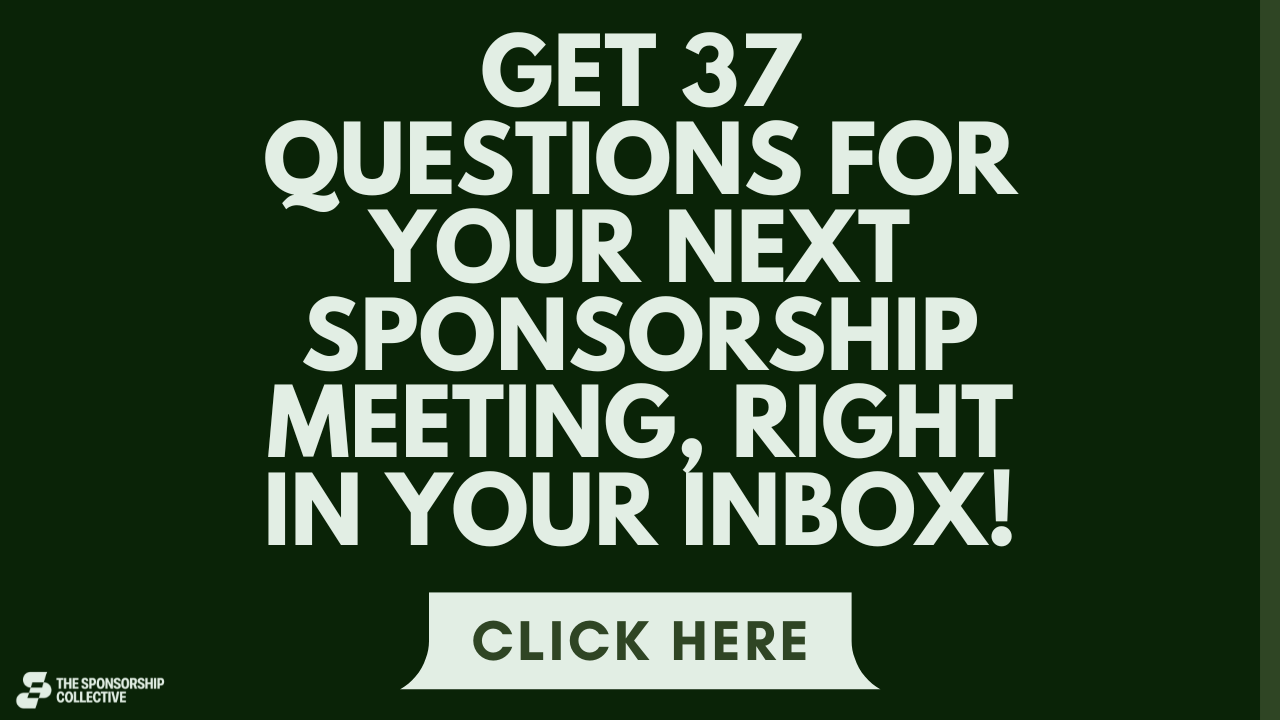
Conclusion
YouTube sponsorship can grow your channel, strengthen your relationship with your audience, and help you position yourself as an influencer. With the guidance in this article, you’re ready to take one huge step into the world of sponsorship!
- About the Author
- Latest Posts
Chris Baylis is the Founder and Editor-in-Chief of The Sponsorship Collective.
After spending several years in the field as a sponsorship professional and consultant, Chris now spends his time working with clients to help them understand their audiences, build activations that sponsors want, apply market values to their assets and build strategies that drive sales.
Read More about Chris Baylis

